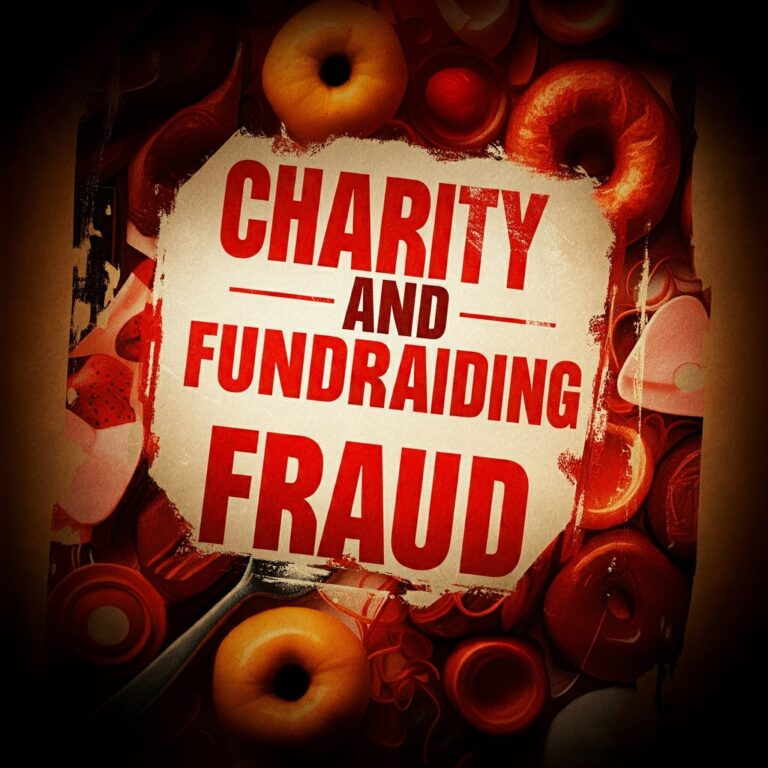In an era where digital connectivity and social awareness have amplified our capacity for compassion, it’s disheartening to acknowledge that scammers continue to exploit our goodwill. Charity and fundraising scams, fueled by evolving technology and sophisticated tactics, remain a persistent threat.
This comprehensive guide aims to equip you with the latest knowledge and insights to navigate the complex landscape of charitable giving, safeguarding your generosity from those who seek to misappropriate it.
Understanding the Landscape of Charity and Fundraising Scams
Sadly, the world of charitable giving isn’t immune to deceit. Scammers, ever opportunistic, have devised a range of tactics to exploit our goodwill. To navigate this landscape safely, it’s vital to familiarize ourselves with the common types of scams and their telltale signs.
Emotional Manipulation: Playing on Heartstrings
- Tragedy Exploitation: Scammers might fabricate heart-wrenching stories about individuals or communities facing dire circumstances. They may use images of sick children, devastated disaster zones, or endangered animals to trigger an immediate emotional response and bypass rational thought.
- Urgency and Pressure: High-pressure tactics are often employed, creating a sense of urgency to donate immediately. Scammers may imply that lives are at stake or that aid will be withheld unless you contribute right away.
Impersonation and False Fronts:
- Fake Charities: Fraudsters create entirely fictitious charities, often with names that closely resemble legitimate organizations. They may set up professional-looking websites and even provide tax-deductible receipts to further their deception.
- Phony Representatives: Scammers may pose as representatives of well-known charities, contacting you by phone, email, or even in person. They might use official-sounding titles, have convincing scripts, or even carry fake identification.
Disaster-Related Scams: Capitalizing on Crises
- Exploiting Sympathy: In the wake of natural disasters or humanitarian crises, scammers prey on the outpouring of compassion. They may create fake fundraising campaigns or impersonate relief organizations to collect donations that never reach the intended recipients.
- Misinformation: Scammers may spread misinformation about the extent of a crisis or the needs of those affected. They might exaggerate the situation to elicit larger donations or create a false sense of urgency.
Online and Tech-Enabled Scams
- Crowdfunding Fraud: While crowdfunding platforms offer a valuable avenue for fundraising, they are not immune to scams. Fraudulent campaigns might misrepresent their goals, provide misleading progress updates, or simply vanish with the funds once the campaign ends.
- Phishing and Malware: Scammers may use deceptive emails or websites to trick you into revealing personal or financial information. They might also embed malware in links or attachments that can infect your computer and steal your data.
Other Common Tactics
- Prize and Lottery Scams: You might receive a notification that you’ve won a prize or lottery, but must donate to a charity to claim your winnings. These are invariably scams designed to extract money from unsuspecting victims.
- “Thank You” Scams: Some fraudsters send unsolicited “gifts” or “thank you” notes, hoping to guilt you into making a donation in return.
Remember: Charity scams can be sophisticated and convincing. Always exercise caution, do your research, and trust your instincts. If something feels off, it’s likely best to err on the side of caution and withhold your donation.
The Evolving Landscape of Charity and Fundraising Scams
As technology advances, so do the methods employed by scammers. While traditional tactics like emotional appeals and impersonation persist, new trends have emerged:
- Cryptocurrency Scams: With the rise of cryptocurrency, scammers are increasingly soliciting donations in Bitcoin and other digital currencies. These transactions are often irreversible, making them attractive to fraudsters.
- Social Media Scams: Social media platforms provide fertile ground for scammers to spread misinformation and create fake fundraising campaigns. Be wary of emotional appeals or requests for donations on social media, especially from unfamiliar accounts.
- AI-Generated Content: Scammers are starting to leverage AI to create convincing deepfake videos or audio recordings, impersonating celebrities or public figures to solicit donations.
Statistics Paint a Concerning Picture
- The Federal Trade Commission (FTC) received over 65,000 reports of charity-related fraud in 2023, with reported losses exceeding $68 million.
- According to a 2023 survey by Charity Navigator, 62% of Americans are concerned about charity scams, and 30% have been personally targeted by such schemes.
- The Better Business Bureau’s (BBB) Wise Giving Alliance estimates that 10% of all donations made to charities are lost to fraud each year.
Understanding Common Scams and Red Flags
Vigilance is key when interacting with any organization seeking your charitable contribution. Be attentive to these warning signs that might indicate a scam:
- High-Pressure Tactics:
- “Donate Now or Miss Out” Mentality: Legitimate charities appreciate any support, whenever it comes. Scammers, however, often create a false sense of urgency, pressuring you with phrases like “limited-time offer,” “donations needed today,” or “last chance to help.” They might even imply that aid will be withheld unless you contribute immediately.
- Relentless Follow-ups: While genuine organizations might send follow-up emails or make polite reminder calls, aggressive and persistent solicitation tactics are a major red flag. If you feel harassed or pressured, trust your instincts and step back.
- Emotional Manipulation Beyond the Norm:
- Overly Sentimental Language: While heartwarming stories can be impactful, be wary of overly sentimental language or graphic imagery designed to evoke strong emotions without providing concrete details about how your donation will be used.
- Guilt-Tripping: Scammers might try to make you feel guilty for not donating, implying that you’re heartless or uncaring if you don’t contribute. Remember, charitable giving should be a personal choice, free from manipulation. 1. Charity scams
- Vague or Unclear Information:
- Elusive Answers: If an organization can’t clearly answer basic questions about their mission, programs, or impact, proceed with caution. Legitimate charities are transparent about their work and should be able to provide specific details about how donations are utilized.
- Lack of Financial Transparency: Be wary of organizations that are reluctant to share their financial information or provide vague explanations about how funds are allocated. Reputable charities are open about their finances and can readily provide annual reports or financial statements upon request. 1. Donating Safely and Avoiding Scams 2. How to Tell if a Charity is Legit
- Unsolicited Contact & Suspicious Communication:
- Out-of-the-Blue Requests: Be cautious of unsolicited phone calls, emails, or text messages soliciting donations, especially if you have no prior connection to the organization. Scammers often use these methods to cast a wide net and target unsuspecting individuals.
- Generic or Impersonal Communication: Legitimate charities typically tailor their communication to their supporters. Generic or impersonal emails or letters, especially those addressed to “Dear Friend” or similar, could be a sign of a scam.
- Typos and Grammatical Errors: Poorly written communication filled with typos and grammatical errors can be a red flag. Reputable organizations take pride in their communication and are less likely to make such mistakes.
- Dubious Payment Methods:
- Cash, Wire Transfers, and Gift Cards: Alarm bells should ring if an organization requests donations through cash, wire transfers, or gift cards. These methods are difficult to trace and favored by scammers, as they offer little recourse for donors in case of fraud.
- Pressure to Pay Immediately: Be wary of organizations that demand immediate payment or offer “special deals” for donating on the spot. Legitimate charities understand that donors need time to consider their contributions and will not pressure you into making hasty decisions. 1. Donate Online To Charity
Remember, your generosity is a precious gift. By staying informed, asking questions, and recognizing these red flags, you can protect yourself from charity scams and empower your giving to make a real difference.
Protecting Yourself in 2024 and Beyond
Knowledge is your most potent weapon against charity scams. By adopting a vigilant and informed approach, you can shield yourself from fraudulent schemes and ensure that your generosity makes a genuine impact.
Before Donating: Do Your Due Diligence
- Thorough Research is Key: Never donate impulsively. Take the time to research any charity or organization before contributing. Verify their legitimacy by checking their website, confirming their registration status with relevant authorities, and looking for independent reviews or ratings.
- Scrutinize Financial Transparency: Reputable charities are transparent about their finances. Look for annual reports or financial statements that detail how donations are used. Be wary of organizations that are reluctant to provide such information.
- Contact the Charity Directly: If you’re unsure about a solicitation, contact the charity directly through their official website or phone number. Verify the request and ask any questions you may have.
During Solicitation: Spotting Red Flags
- High-Pressure Tactics: Be suspicious of any requests for immediate donations or the use of high-pressure tactics. Legitimate charities understand that donors need time to consider their contributions.
- Emotional Manipulation: While genuine charities may share stories of those they help, beware of excessive emotional appeals or attempts to guilt you into donating.
- Vague or Unclear Information: Reputable charities can clearly articulate their mission, programs, and impact. Be wary of organizations that provide vague or evasive answers to your questions.
- Unsolicited Contact: Exercise caution when receiving unsolicited calls, emails, or text messages requesting donations. Scammers often use these methods to target unsuspecting victims.
- Requests for Unusual Payment Methods: Legitimate charities typically accept donations through secure online platforms, credit cards, or checks. Be wary of requests for cash, wire transfers, or gift cards, as these are often favored by scammers.
After Donating: Stay Vigilant
- Monitor Your Statements: Keep an eye on your bank and credit card statements for any unauthorized transactions. If you notice anything suspicious, contact your financial institution immediately. 1. malwaretips.com
- Report Suspected Scams: If you believe you’ve been targeted by a charity scam, report it to the appropriate authorities, such as your local consumer protection agency or the Federal Trade Commission. Your report can help prevent others from falling victim to the same scheme.
Additional Tips:
- Don’t Click on Suspicious Links: Avoid clicking on links or downloading attachments from unsolicited emails or text messages, even if they appear to be from a legitimate charity.
- Protect Your Personal Information: Never provide your Social Security number, bank account information, or other sensitive data to anyone soliciting a donation.
- Consider Monthly Giving: Instead of making one-time donations, consider setting up recurring monthly contributions to your chosen charities. This can help you avoid impulsive giving and ensure a steady stream of support.
Remember: Your generosity is valuable. By staying informed, asking questions, and following these tips, you can protect yourself from charity scams and make a meaningful difference in the world.
Additional Precautions for 2024:
- Verify Cryptocurrency Addresses: If donating cryptocurrency, double-check the recipient’s wallet address. Scammers often create fake addresses that closely resemble legitimate ones.
- Be Skeptical of Social Media Appeals: Exercise caution when encountering fundraising campaigns or requests for donations on social media. Verify the authenticity of the account and the campaign before contributing.
- Question Deepfake Content: If you encounter videos or audio recordings that seem too good to be true, question their authenticity. Scammers are increasingly using AI to create convincing deepfakes.
Your Generosity Matters
By staying informed, vigilant, and proactive, you can ensure that your charitable contributions make a genuine impact. Remember, your compassion is a powerful force for good. Don’t let scammers discourage you from making a positive difference in the world.















